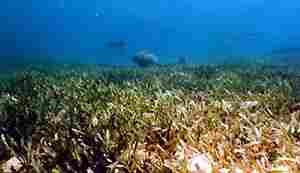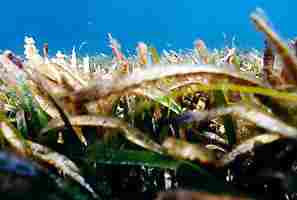

Seagrasses - What Role Do They Play?
Sea Grasses

Seagrasses are flowering plants that are an important part of the food web. They provide food for turtles, manatees and a variety of fish and habitat for filter-feeding organisms and foraging sea life such as sea urchins and sea cucumbers. Seagrasses are a nursery ground for pink shrimp, lobster, snapper and other sea life and stabilize the ocean bottom by trapping sediments


Seagrasses offer food and habitat for juvenile fish, crustaceans and shellfish. They filter the water of sediments, release oxygen into the water and stabilize the bottom with their roots.
THREATS TO SEAGRASSES
Seagrasses are related to land based plants. Like them, they have leaves, stems and flowers, as well as roots. In healthy beds, when leaves are damaged from storms, unusual cold, or overgrazing, seagrasses grow back quickly. But prop dredging, causing deep cuts in the ocean floor, causes damage to the root systems of seagrasses. These "cuts," most often caused by water jet skis and motorboats, make scars in the seagrass meadows that take years to re-grow.
A quick overhead view from a plane over the Florida Keys show literally millions of straight lines in the seagrass meadows. These lines are cuts made by prop dredging. In rough weather, vast clouds of calcium carbonate -- the limestone that was created from ancient coral beds -- becomes suspended in the water and severely limits visibility for days.


Photos by Curtis Kruer
WATER QUALITY DECLINE
WATER QUALITY DECLINE, caused by the destruction of mangrove forests, farm run-off, storm water run-off, and inadequate sewage treatment are devastating these vital habitats. Nutrients from these sources often cause an overload of algae that infest seagrass, weaken their root systems, and make it difficult for them to photosynthesize. Free floating algae from over-nutrification also destroys the seagrass meadows by depriving them of sunlight and oxygen, so necessary for them to survive.
BOATING TIPS
If you do run into a grass bed, you'll be leaving behind a mud trail where your prop has churned up the bay bottom, clouded the water, and likely cut seagrass roots. It's what you do next that counts: STOP! TILT YOUR MOTOR. POLE OR WALK YOUR BOAT FREE.
HOW TO AVOID RUNNING INTO SEAGRASS MEADOWS
- CONSULT TIDE CHARTS. Even at high tides some seagrass areas are too shallow for safe navigation;
- STAY IN MARKED CHANNELS, consult navigational charts.
- LEARN TO READ THE WATER. Seagrasses appear as large dark areas beneath the water.
REMEMBER:
"Brown, brown, run aground,
Blue, blue sail on through.
White, white you just might."
If the biota, in the course of aeons, has built something we like but do not understand, then who but a fool would discard seemingly useless parts? To keep every cog and wheel is the first precaution of intelligent tinkering. Aldo Leopold, Round River, 1993.
Reef Relief Founders.com


